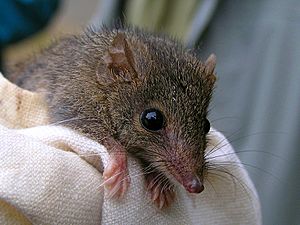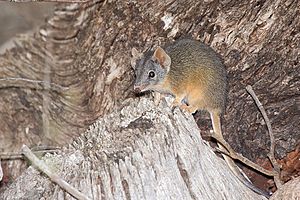Antechinus facts for kids
Quick facts for kids Antechinus |
|
|---|---|
 |
|
| Scientific classification |
|
| Kingdom: | Animalia |
| Phylum: | Chordata |
| Class: | Mammalia |
| Infraclass: | Marsupialia |
| Order: | Dasyuromorphia |
| Family: | Dasyuridae |
| Subfamily: | Dasyurinae |
| Tribe: | Phascogalini |
| Genus: | Antechinus Macleay, 1841 |
| Type species | |
| Antechinus stuartii Macleay, 1841
|
|
| Species | |
|
|
Antechinus (pronounced 'ant-echinus') are small, mouse-like animals found only in Australia. They are a type of marsupial, which means the females carry their babies in a pouch or a skin fold. These furry creatures look a bit like mice but have bristly fur, similar to shrews. People sometimes call them "broad-footed marsupial mice" or "pouched mice," but their modern name is simply Antechinus.
Antechinus have short, dense, and soft fur. Their fur is usually grey or brown, but the exact color changes depending on the species. Their tails are thin and can be a bit shorter or longer than their body. They have cone-shaped heads and small to medium-sized ears. Some species have a long, narrow snout, making them look even more like shrews.
These animals range in size. They can be from 12 to 31 centimeters (about 5 to 12 inches) long. When fully grown, they weigh between 16 and 170 grams (about 0.5 to 6 ounces). The A. agilis is the smallest known species, while the A. swainsonii is the largest. Male Antechinus are usually bigger and heavier than females.
Most Antechinus species live together in tree hollows. They prefer to live in forests, woodlands, and rainforests. Some species also live in heaths and grasslands. Most Antechinus are found along the eastern coast of Australia, near the Great Dividing Range. One species, A. flavipes, lives in southwest Western Australia. Another species, A. bellus, lives in northern Australia, near the Gulf of Carpentaria.
Contents
Antechinus Species and Groups
There are currently 15 known species of Antechinus. Scientists are still studying how these species are related to each other. Some Antechinus species from New Guinea were once thought to be part of this group, but they have now been moved to a different genus called Murexia.
Scientists group Antechinus into four main clades, or groups, based on how closely they are related. These groups often include species that live in similar areas.
- Dusky Antechinus Group: This group includes species like the black-tailed antechinus and the swamp antechinus.
- Atherton Antechinus Group: This group has only one species, the Atherton antechinus.
- Brown Antechinus Group: This group includes the agile antechinus and the brown antechinus.
- Other Antechinus Group: This group contains species such as the silver-headed antechinus and the yellow-footed antechinus.
What Antechinus Eat
Antechinus mostly eat insects. They are known as generalists because they eat many different kinds of food. They are also opportunists, meaning they will eat whatever food is available.
Their diet often includes beetles, insect larvae, and spiders. They also eat small creatures like amphipods, millipedes, and centipedes. After a bushfire, Antechinus might eat mostly ants because ants are often the only insects left. Sometimes, they even eat small reptiles like skinks or small mammals like feathertail gliders. This usually happens when they are very hungry. Bits of plants have also been found in their droppings, but these were likely eaten by accident.
Antechinus use different ways to find food. Smaller species, like A. stuartii, are good at climbing trees. They hunt in trees and have even been seen jumping between branches to catch flying insects. Larger species, such as A. swainsonii, live only on the ground. They search for food in the leaf litter. As Antechinus get older, they become better hunters. They learn which prey are the best to eat. They have even been seen scraping slugs on rocks to remove the slimy mucus before eating them!
Antechinus Reproduction and Life Cycle
Antechinus have a very unusual way of reproducing. Females have a short breeding period of about three weeks. During this time, they are ready to mate. What makes them unique is that almost all male Antechinus die after this mating period. Only in very rare cases do males survive. Females often mate twice or even three times in their lives.
The babies develop inside the mother for 25 to 35 days. After they are born, it takes about 90 to 100 days for the young to become independent. This is quite a long time compared to other marsupials of similar size.
When Breeding Happens
The breeding season for Antechinus happens in winter or early spring, from July to September. The exact timing depends on the species and where they live. The length of the day, called the photoperiod, helps them know when to start breeding. Different species react to different changes in day length. For example, most A. stuartii females become ready to mate when the day length increases by a certain amount each day.
Antechinus live in stable environments along Australia's east coast. By using day length to time their breeding, they make sure their babies are growing when there is plenty of food available. This helps the young survive and thrive.
Many Antechinus species live in the same areas. When this happens, their breeding times are slightly different. This difference in timing helps prevent them from mating with each other. It also means they can use different food sources that become available at slightly different times in spring and summer. Larger Antechinus species usually mate first. Smaller species might have evolved to mate later to avoid competition for food.
Male Antechinus Life Cycle
Male Antechinus put all their energy into one breeding season. This intense effort leads to their death shortly after mating. This is a natural part of their life cycle. It allows them to focus completely on reproducing, even if it means they won't survive to the next year.
This unique breeding system, where all males die, might have several benefits. It ensures that as many matings as possible happen during the short breeding period. It also means males can give their absolute best effort to reproduction. Another idea is that having many babies born at the same time might help protect them from predators. If there are many young, predators can't eat them all.
Female Antechinus Anatomy
Female Antechinus do not have a full pouch like kangaroos. Instead, they have a flap of skin that covers their teats (nipples). The number of teats can vary, from 6 to 13, even within the same species. Females with fewer teats are more likely to survive to breed again. This is probably because raising a smaller number of babies is less stressful. Larger species, like A. swainsonii, are more likely to reproduce a second time.
Mating Behavior
Mating for Antechinus is very intense and can last up to 12 hours for some species. Males will mate with many females, and the babies in one litter can have different fathers. During the short breeding time, males travel more widely and are active both day and night. Young males leave their mothers' nests once they can live on their own. This helps prevent them from mating with their relatives.
Torpor: Energy Saving Mode
Torpor is like a short, deep nap that Antechinus take to save energy. It means they lower their body temperature and slow down their metabolism. This helps them use less food and water. Many marsupials, birds, and other mammals use torpor.
There are two main types of torpor:
- Hibernation is a very long sleep that lasts for weeks or months.
- Daily torpor is much shorter, usually only a few hours. Antechinus use daily torpor.
Antechinus can go into torpor even on warm summer days. This is called spontaneous torpor. They might also go into torpor if they don't have enough food or water. In the wild, torpor is likely a mix of these reasons.
Antechinus are small, so they lose heat quickly. They also have a high metabolism. Going into torpor can reduce their metabolism by up to 80%. This saves a lot of energy, food, and water. This is especially helpful during droughts.
Antechinus usually go into torpor during their rest periods. This might be in the early morning after hunting all night or in the late afternoon before they start hunting. Sometimes, they even go into torpor during the night.
Body size affects torpor. Larger Antechinus are less likely to go into torpor and stay in it for shorter times. This means males go into torpor less often than females. Females who are feeding babies do not go into torpor. Antechinus can stay in torpor for one to nine hours, and sometimes even up to 20 hours. Their body temperature drops a lot. For female A. flavipes, their body temperature can drop to around 20°C (68°F). For males, it's higher, around 30°C (86°F). Smaller animals have lower body temperatures during torpor.
After intense bushfires, Antechinus use torpor more often. Fires destroy their shelter and food. Torpor helps them survive by reducing their need to find food, which also helps them avoid predators. Smoke, ash, and charcoal can even trigger them to go into torpor.
Warming up after torpor uses a lot of energy. However, Antechinus have been seen basking in the sun to warm up without using more food. Older female Antechinus, even though they are larger, go into torpor more often than younger females. This might be because younger females are still growing and need more food. Older females are also better at finding food quickly.
Threats to Antechinus
Two species, A. arktos and A. argentus, are currently listed as endangered. The biggest dangers to all Antechinus species are habitat destruction and introduced animals.
When forests are cut down, Antechinus lose their homes and places to hide from predators. They also lose their food sources. Antechinus build nests in tree hollows, which only form in old trees.
Animals brought to Australia by humans also threaten Antechinus. Foxes and cats hunt Antechinus. Introduced rats and mice also compete with Antechinus for food and places to live. Pigs, cattle, and horses can damage their habitats by trampling them.
Changes in fire patterns since Europeans arrived have led to more intense bushfires. These fires can harm Antechinus populations by destroying the plants they rely on for shelter and food.
Climate change also threatens several Antechinus species that live in high-altitude areas, especially in northern Queensland.
See also
 In Spanish: Antequinos o ratones marsupiales dentones para niños
In Spanish: Antequinos o ratones marsupiales dentones para niños




